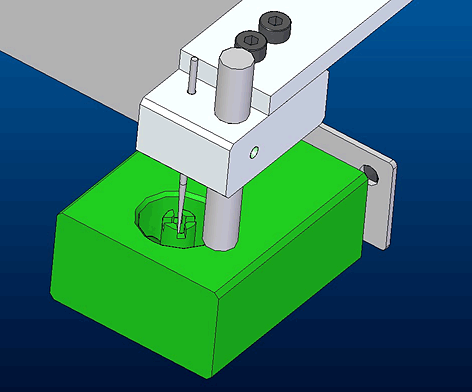The Zetasizer Auto Plate Sampler (APS) employs a carefully designed plate sampling technology to optimize sampling time and maintain sensitivity, while at the same time ensuring that all the samples are maintained in optimal condition as each of the samples in the 96- or 384-well plates are being measured.
The Zetasizer APS uses a needle with an internal and external hydrophobic coating to minimize sample adsorption on the surface of the needle.
The needle and tubing are cleaned in a wash station, where the needle is inserted into the wash well, (figure 1) and the rinse fluid is flushed through the tubing and exits through the needle into the well. The well side has slits to guide the liquid to flow over the sides and into the waste collection. The needle is inserted into the well to allow the rinse fluid to rinse the outside of the needle as well as the inside. The rinse procedure occurs before the first measurement and then in between the measurement of every sample.

|
To ensure that the tubing and measurement cell are clean, the background light scattered from the rinse fluid is measured in between each sample and this value is stored with the results so the user can verify that the rinsing procedure has completely flushed the flow cell.
Before the sample is transported to the measurement cell, a small amount of air is introduced into the needle to create an air bubble, which acts as a barrier between the sample and the rinse fluid to minimize mixing and possible dilution of the sample.
After the rinsing procedure, the sampling arm holding the needle is moved to the first well to be measured. The needle samples 20µl of liquid from the well and transports it through the tubing to the measurement flow cell.
In the measurement flow cell, the sample temperature is equilibrated to the requested value and the laser intensity is optimized for measurement using both adjustment of the laser power and adjustment of an attenuator. The combination of these two mechanisms gives an attenuation range of 10,000,000:1.
After the measurement, the sample is either returned to its original well in the plate or optionally rejected to waste before the rinsing procedure takes place. This may be required because the protein has been intentionally degraded during a thermal scan of the sample.
During the total time required to measure all the samples, the 96- or 384-well plate is kept at a constant temperature by a separate plate temperature controller in order to maintain the samples in optimal condition.
DLS plate sampling technology ensures that the optimal conditions are maintained for the samples before measurement and the unparalleled sensitivity for multiple samples preserved.

|